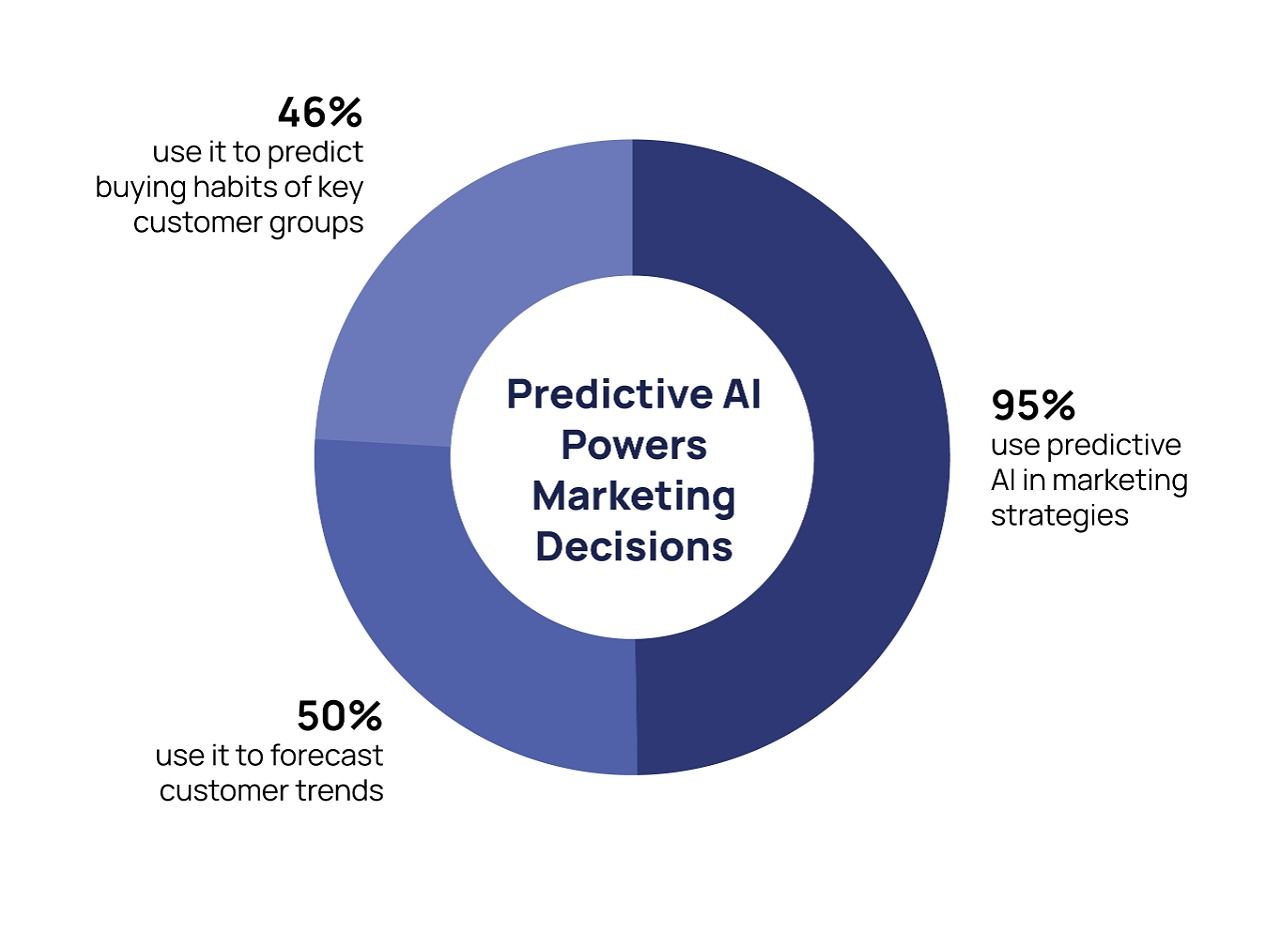
Target the Right Audience with Predictive Analytics in Marketing

Want to know what’s working across all your channels before you even launch? Use predictive analytics in marketing to forecast impact, then apply AI in marketing strategy to fine-tune creative and spend. That’s how predictive analytics helps improve marketing ROI by removing guesswork from your go-to-market. Scroll down to see how marketers are using this now.
Transform Marketing Decisions with AI Predictive Analytics
Marketing today runs on data, but raw numbers alone don’t tell you what’s next. That’s where AI in marketing strategy and predictive analytics steps in. It uses machine learning and advanced algorithms to sift through historical data, find patterns, and forecast future outcomes. In short, it helps you see what’s likely to happen before it does.
For marketers, this marks a significant shift in marketing strategy. Instead of guessing which campaign might work or relying on past trends that may no longer apply, you get forward-looking insights grounded in real behavior. AI predictive analytics shows you which customers are likely to churn, which leads are most likely to convert, and what content will perform best, before you even launch a campaign. This type of marketing decision-making with AI enables teams to act with greater confidence and reduced trial and error.
This shift isn’t about collecting more data; it’s about utilizing the data you already have more effectively. Traditional analytics tells you what happened. Predictive analytics for decision-making tells you what’s coming. You can personalize messaging, time your outreach, adjust media spend, and plan product launches with far more confidence. Instead of reacting to changes, you’re anticipating them.
In a market where speed and relevance determine who receives attention and who gets ignored, real-time campaign optimization enables marketing teams to transition from intuition to intelligent, data-driven action.
From Data to Prediction: How AI and Analytics Work in Sync
Predictive analytics and AI work together to turn historical and real-time data into actionable forecasts. This process involves a set of iterative stages that extract patterns, build models, and generate future insights.
Let’s take a closer look at how this system functions:
Structured Data Collection
You start by collecting data from multiple sources, such as sales transactions, user activity logs, IoT sensors, and more. The raw data is messy, so cleaning and pre-processing are necessary to fix errors, fill in gaps, and format the input. Without this step, the models won’t perform reliably.
Model Training with Machine Learning
After preparation, machine learning models are built and trained using historical data. The model learns relationships and trends from this data. The algorithm you choose, such as linear regression, decision trees, or deep learning, affects the model’s complexity and accuracy. The better the data reflects the real world, the more useful the patterns the model will learn.
Performance Testing
Before launching, you need to know how well the model performs on new data. That’s where validation and testing come in. You use a separate data set (not used in training) to evaluate accuracy. This helps identify overfitting and ensures the model performs effectively beyond the sample from which it was trained.
Operational Deployment
Once tested, the model moves into production, analyzing live data and making real-time predictions. In marketing, this enables examples of real-time marketing optimization using AI, like dynamic ad spend or personalized content. This type of campaign optimization with predictive data allows teams to respond more quickly and refine targeting mid-campaign.
Adaptive Feedback Loops
AI models aren’t fixed. As they get exposed to new data, they can be retrained or updated. This keeps predictions aligned with changing patterns. Ongoing learning helps prevent model decay and keeps your forecasts sharp and accurate.
Key Elements That Make AI Predictive Analytics Work
If you’re considering using AI to support your marketing or business strategy, it’s helpful first to understand how predictive analytics works. At its core, AI predictive analytics is built on three parts: data, algorithms, and predictions. Each one plays a specific role in helping you anticipate what’s coming next.
Here are the main components that make predictive analytics work for you:
Your Data Is the Foundation
To obtain predictions, you need a lot of data. This includes everything from customer behavior, sales records, web activity, and any other digital footprint.
What matters is that the data is:
- Accurate: Errors or gaps weaken your results
- Relevant: Only data that reflects your business goals is useful
- Historical: You need past patterns to predict future ones
You’ll also need to clean and prep this data. That means organizing it, filling in any missing values, and preparing it for analysis. This is the backbone of strategic marketing with data.
Algorithms Do the Heavy Lifting
Algorithms are step-by-step instructions, but in AI, they’re much more sophisticated. They learn from your data and improve over time. Some models are simple; others (like deep learning) handle massive, complex datasets.
Here’s what algorithms help you do:
- Spot patterns that aren’t obvious to the human eye
- Process more data than your team ever could
- Customize insights for your specific use case
Choosing the correct algorithm depends on what you’re trying to predict and the type of data you have. Predictive marketing models help tailor these decisions for different campaign goals.
Predictions Drive Your Decisions
This is the part where you get value. The algorithm processes your data and outputs predictions, such as future sales, customer behavior, and campaign performance.
What you can do with predictions:
- Test new ideas with less risk
- Plan your next campaign based on real data
- Adapt faster by learning from what the AI gets right or wrong
You can also feed actual results back into the system to make it smarter over time. These AI-powered analytics tools bring marketing teams closer to real, usable insights.
The Real Impact of AI Predictive Analytics on Business Outcomes
AI predictive analytics helps you make smarter, faster decisions using data. It eliminates the guesswork from planning and enables you to respond to challenges before they arise. You get better results across your business from operations and strategy to customer experience.
Let’s explore how it works for you:
Stronger Choices with Less Guesswork
AI finds patterns in your data and highlights what matters. You can make decisions faster, with more confidence, and align your plans with what’s likely to happen, not what you hope will happen.
Fewer Surprises, More Control
You don’t have to wait for something to go wrong. Predictive analytics provides early signals, such as when a part might fail or demand might spike, allowing you to act before minor issues become major problems. This foresight also supports consumer journey prediction, helping teams tailor campaigns before customer intent shifts.
Simpler, Faster Processes
By forecasting needs and removing friction points, AI helps you keep things moving. Whether you’re managing inventory or scheduling staff, it enables you to reduce delays, cut waste, and work more efficiently. For campaign teams, it allows marketing performance optimization across planning, execution, and measurement.
More Relevant Customer Interactions
You can use data to understand what each customer wants before they ask. AI helps you offer better recommendations, personalize communication, and create experiences that feel timely and relevant.
Faster Response to Potential Risks
AI helps you spot unusual behavior or patterns early. It could mean catching fraud, spotting system failures, or flagging compliance issues before they escalate into something more serious.
Smarter Use of Your Resources
AI helps you predict what you’ll need and when. That means less overspending, less overproduction, and fewer missed opportunities, so your time, budget, and staff are focused where they’ll have the most impact.
Clearer View Across Your Data
AI connects your data from various sources, making it easier to identify what’s working and what’s not. Teams get aligned faster, and you can base your decisions on the whole picture, not scattered information.
Faster Adaptation to Changing Needs
Markets shift, customer behavior changes, and new risks emerge. AI predictive analytics helps you adapt quickly by showing what’s likely to happen next so you can adjust without falling behind.
Industry-wise Use of AI Predictive Analytics in Marketing
AI predictive analytics enhances marketing by helping businesses predict customer behavior, segment audiences, personalize messaging, and optimize campaign performance. Its impact spans across industries, each using predictive insights to drive smarter engagement and improve ROI. Approximately 32% of media and entertainment executives believe that AI-powered forecasting and predictive analytics would significantly enhance their organization’s ability to monitor and understand operations, signaling growing adoption even beyond traditional data-intensive sectors.
Here are the key ways AI predictive analytics supports marketing across different sectors:
Retail and E-commerce
Retailers and e-commerce companies use AI predictive analytics to personalize product recommendations, optimize promotions, and target customers based on their browsing and purchase behavior. It supports dynamic pricing strategies, enhances inventory planning, and facilitates forecasting of customer lifetime value, allowing marketers to focus their efforts where the return is highest. Many are now deploying marketing automation using AI to execute campaigns based on real-time customer signals. By predicting shopping trends and segmenting customers based on behavior and preferences, these companies can run more targeted and timely campaigns.
Finance and Banking
Financial institutions apply AI predictive analytics to personalize offers, predict customer churn, and assess risk in marketing decisions. It helps banks target credit products to the right segments by analyzing historical and behavioral data. Churn prediction enables proactive retention campaigns, while fraud detection models inform customer-facing messaging about security and trust, ensuring a seamless customer experience. These insights allow marketing teams to prioritize the right customers with relevant offers, thereby reducing wasted spend. Financial institutions that adopted predictive analytics achieved an ROI of 200% to 500% within the first year of use, demonstrating the practicality of this approach when applied across multiple touchpoints, from retention to acquisition.
Healthcare and Life Sciences
In healthcare, AI predictive analytics is used to identify patients who are likely to miss appointments, need follow-up care, or benefit from specific treatment plans. Marketing and outreach teams use this information to personalize messages and engagement strategies, such as reminders for screenings or wellness programs. Predictive insights also help healthcare organizations promote preventative care services and reduce patient drop-off by timing communications more effectively.
Manufacturing and Industrial B2B
Manufacturers leverage AI predictive analytics to prioritize high-value leads, align marketing with production forecasts, and tailor content based on customer purchase cycles. It supports account-based marketing by identifying which businesses are most likely to convert based on engagement signals and historical patterns. Predictive models also inform campaign timing and messaging, helping marketers better align with procurement and supply chain cycles.
Telecommunications and Utilities
Telecom and utility providers use AI predictive analytics to identify customers at risk of churn and create personalized retention campaigns. It enables the targeting of upsell offers based on usage data and customer preferences, helping marketing teams deliver more relevant service packages. Predictive models also help anticipate network issues and inform proactive communication strategies that maintain trust and reduce complaints.
Education and EdTech
Educational institutions utilize AI predictive analytics to enhance enrollment marketing and improve student retention. By identifying students likely to disengage or drop out, marketing teams can target them with support-focused content and outreach. Predictive insights also guide campaign timing around enrollment cycles, helping institutions reach the right students with the right programs. Personalized learning recommendations based on student data support ongoing engagement and satisfaction.
Transportation and Logistics
In transportation and logistics, AI predictive analytics supports marketing by forecasting customer demand and identifying high-value users. It helps optimize route-specific offers, schedule promotions during peak periods, and predict customer churn in subscription-based services. Marketing teams utilize these insights to enhance loyalty campaigns, tailor service notifications, and align offers with delivery patterns or usage behaviors.

Building a Practical AI Predictive Analytics Strategy for Marketing
AI predictive analytics helps you anticipate customer behavior, improve targeting, and optimize campaign performance. But turning raw data into useful predictions takes more than just plugging in a tool. You need a clear roadmap that connects business goals, clean data, the right technology, and continuous learning.
Here’s how to structure your marketing-focused AI predictive analytics efforts effectively:
Pinpoint Specific Marketing Use Cases
Start by identifying what marketing problems you’re solving. Are you trying to reduce customer churn, improve ad targeting, or increase upsell rates? Define measurable success metrics, such as click-through rate, retention rate, conversion rate, and revenue impact. This aligns closely with how predictive analytics helps improve marketing ROI, especially when tied to campaign outcomes.
- Clarify whether you’re focused on acquisition, engagement, retention, or monetization
- Translate marketing objectives into clear problem statements for analytics
- Set KPIs tied directly to campaign or funnel improvements
Assemble a Cross-disciplinary Team
AI in marketing isn’t just a data project; it’s a team effort. You need input from multiple roles to avoid building something disconnected from day-to-day marketing.
- Include marketers, data engineers, analysts, and IT in planning and execution
- Assign clear ownership for data preparation, modeling, integration, and usage
- Use outside consultants or vendors only where internal skill gaps exist
Audit, Clean, and Organize Marketing Data
Good models need good data. If the data is inconsistent or irrelevant, even the best models will deliver poor predictions.
- Source data from CRM, campaign tools, website tracking, and purchase logs
- Clean the data by fixing missing fields, standardizing formats, and removing duplicates
- Consolidate data across silos to create a comprehensive view of the customer journey
Choose Tools That Fit Your Team and Goals
Don’t chase the most complex tech; choose what fits. Consider ease of use, existing team skills, and integration with your current stack.
- Use Python, R, or Spark for complete control if you have data science capacity
- Consider platforms like Salesforce Einstein or Azure ML for faster deployment
- Pair predictive systems with visualization tools (e.g., Tableau, Power BI) for adoption
Build Targeted, Testable Prediction Models
Select modeling techniques that align with your marketing objectives. Train models on real marketing data and then test them before using them in production.
- Use classification for churn or conversion predictions
- Use clustering to group customers by behavioral or demographic patterns
- Use regression for campaign ROI forecasting or lifetime value estimation
Operationalize the Model into Marketing Systems
Getting predictions is just the start; use them in real-time campaigns and workflows to drive actionable insights.
- Connect your model to marketing systems (e.g., CRM, email automation)
- Trigger actions like content personalization or bid adjustments from predictions
- Build dashboards that show marketing teams what the predictions mean
Track Performance and Optimize Continuously
Model performance degrades over time without updates. You need a process for constant review and tuning.
- Monitor accuracy and relevance of predictions against actual outcomes
- Retrain the model regularly with fresh data and updated features
- Use A/B testing to measure performance against non-AI methods
Translate Predictions into Clear, Actionable Insights
Models are only valid if marketers understand and apply the results.
- Avoid technical output—present insights as actions (e.g., who to target, what to offer)
- Align model outputs with campaign planning, creative, and channel strategy
- Equip teams with tools or dashboards that translate predictions into priorities
Address Ethics, Privacy, and Model Transparency
Predictive analytics must respect privacy and avoid unintended harm.
- Audit models for bias, especially in targeting and scoring
- Document how predictions are made and which data is used
- Make sure you comply with GDPR, CCPA, and any internal policies
Make Smarter Marketing Moves with JynAI's Predictive Analytics
JynAI helps companies monitor social media and manage brand reputation by turning raw data into strategic inputs. Using AI, it tracks brand mentions, sentiment trends, influencer activity, competitor signals, and customer conversations across various platforms, including LinkedIn, Twitter, Reddit, Instagram, and others. Instead of relying on manual searches or scattered tools, JynAI gives you a single, organized view of what’s being said, where, and by whom. It flags significant changes, such as positive or negative ones, so your team can respond quickly and make better decisions with context that matters.
Built on the Panorama platform, JynAI is designed for real-world applications, not demonstrations. It integrates into your existing tools and workflows, eliminating the need for extra setup, training, or system changes. Whether you’re handling marketing alone or working with a larger team, JynAI provides you with better visibility, more control, and fewer distractions. With AI-powered monitoring, decision-ready data, and a focus on clarity and speed, teams can move more quickly and concentrate on what truly matters.
Sign up for free to start using JynAI for social media monitoring and brand reputation tracking.
FAQs
How does predictive AI influence marketing strategies?
Predictive AI utilizes historical and real-time data to forecast customer behavior, such as who is likely to convert, churn, or engage. Marketers can use these insights to target specific segments, personalize messaging, and time campaigns more effectively. This shifts strategies from reactive to proactive.
How does predictive analytics improve customer segmentation?
Instead of using broad demographics, AI groups customers based on behavior, preferences, and intent. These dynamic segments are more actionable, allowing for tailored messaging and higher response rates. You reach the right people with the right message at the right time.
What types of data feed predictive analytics in marketing?
AI models typically use CRM data, website behavior, purchase history, social interactions, and email engagement. The more integrated and clean the data, the better the predictions. Combining sources provides a more comprehensive picture of each customer’s journey.
Is predictive analytics useful for customer retention?
Absolutely. AI can identify signals that a customer might churn, such as reduced engagement or changes in buying patterns, before they occur. Marketers can then intervene with retention offers, personalized messages, or loyalty campaigns.
How quickly can predictive models impact results?
Once trained and deployed, predictive models can start influencing campaign decisions almost immediately. Within a few weeks, you can typically see improvements in targeting, engagement rates, and conversion. The speed depends on the quality of the data and the complexity of the model.
Are You Ready to Make AI Work for You?
Simplify your AI journey with solutions that integrate seamlessly, empower your teams, and deliver real results. Jyn turns complexity into a clear path to success.



